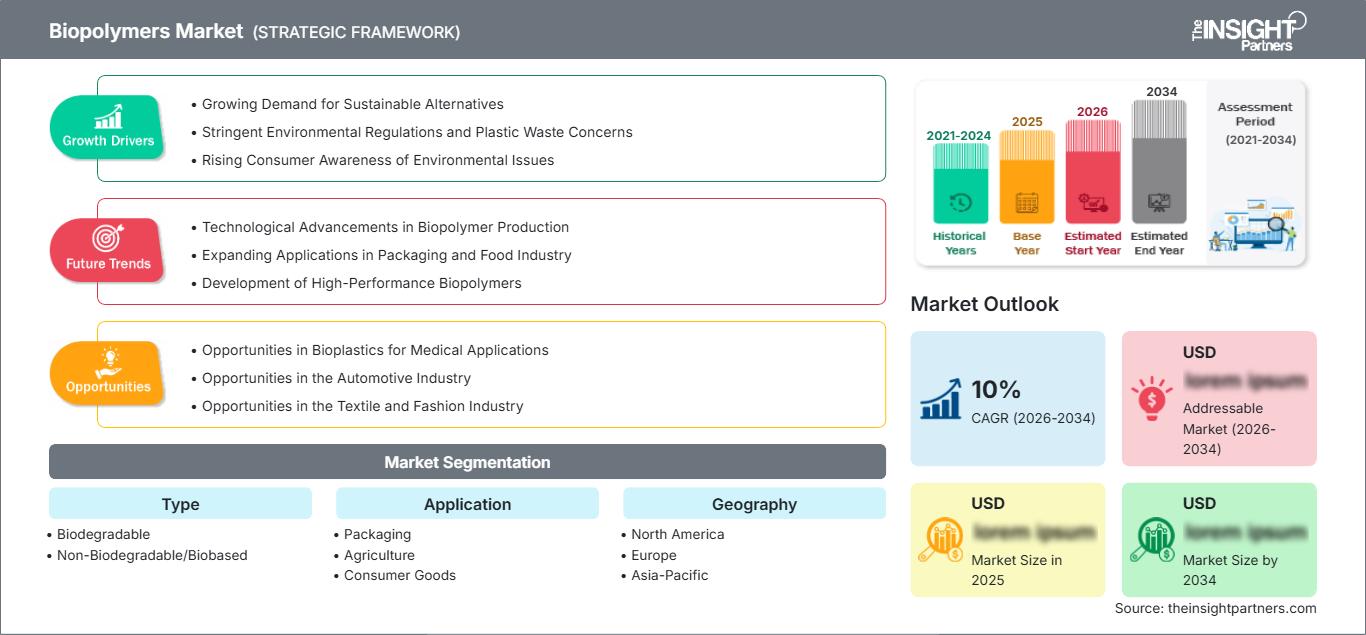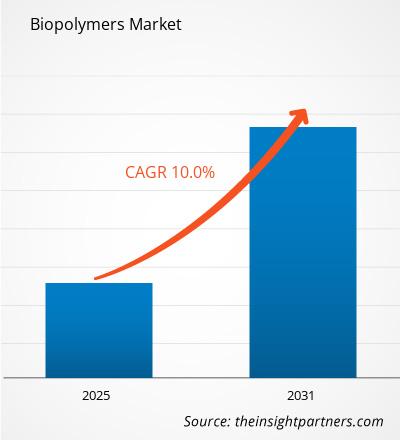Se prevé que el mercado de biopolímeros se expanda a una tasa de crecimiento anual compuesta (TCAC) del 10 % entre 2026 y 2034. Las condiciones del mercado siguen evolucionando, lo que genera nuevas oportunidades para las partes interesadas. El panorama general refleja un progreso estable y un potencial de crecimiento a largo plazo.
El informe presenta un análisis basado en el tipo [biodegradable (PLA, mezclas de almidón, PHA, PCL, PBS y otros) y no biodegradable/de base biológica (bio-PET, bio-PE, bio-PTT, bio-PP y otros)]. El informe está segmentado por aplicación (embalaje, agricultura, bienes de consumo, automoción y transporte, textiles, construcción y otros). El análisis global se desglosa a nivel regional y por países principales. El alcance del informe abarca el tamaño y las previsiones del mercado a nivel global, regional y nacional para todos los segmentos clave del mercado. El informe ofrece el valor en USD para el análisis y los segmentos mencionados. El informe proporciona estadísticas clave sobre el estado del mercado de los principales actores del mercado y presenta tendencias y oportunidades del mercado.
Propósito del Informe
El informe "Mercado de Biopolímeros" de The Insight Partners busca describir el panorama actual y el crecimiento futuro, los principales factores impulsores, los desafíos y las oportunidades. Esto proporcionará información a diversos actores del sector, como:
- Proveedores/fabricantes de tecnología: Para comprender la dinámica cambiante del mercado y conocer las oportunidades potenciales de crecimiento, lo que les permitirá tomar decisiones estratégicas informadas.
- Inversores: Realizar un análisis exhaustivo de tendencias respecto a la tasa de crecimiento del mercado, las proyecciones financieras del mercado y las oportunidades que existen en toda la cadena de valor.
- Órganos reguladores: Regular las políticas y las actividades policiales en el mercado con el objetivo de minimizar el abuso, preservar la confianza de los inversores y defender la integridad y estabilidad del mercado.
Segmentación del mercado de biopolímeros
- Biodegradable
- No biodegradable/de base biológica
Solicitud
- Embalaje
- Agricultura
- Bienes de consumo
- Automoción y transporte
- Textiles
- Construcción y edificación
Obtendrá personalización en cualquier informe, sin cargo, incluidas partes de este informe o análisis a nivel de país, paquete de datos de Excel, así como también grandes ofertas y descuentos para empresas emergentes y universidades.
Mercado de biopolímeros: perspectivas estratégicas

-
Obtenga las principales tendencias clave del mercado de este informe.Esta muestra GRATUITA incluirá análisis de datos, desde tendencias del mercado hasta estimaciones y pronósticos.
Factores que impulsan el crecimiento del mercado de biopolímeros
- Creciente demanda de alternativas sostenibles: La creciente demanda de materiales ecológicos en sectores como el embalaje, la automoción, el textil y la salud está impulsando significativamente el crecimiento del mercado de biopolímeros. Los biopolímeros, derivados de recursos renovables como plantas, algas y microorganismos, ofrecen una alternativa a los plásticos convencionales derivados del petróleo. A medida que la sostenibilidad se convierte en un valor fundamental para fabricantes y consumidores, los biopolímeros emergen como una solución para reducir el impacto ambiental, impulsando el mercado.
- Regulaciones ambientales estrictas y preocupación por los residuos plásticos: Gobiernos de todo el mundo están implementando regulaciones estrictas para frenar la contaminación plástica y reducir la dependencia de materiales derivados de combustibles fósiles. La creciente prohibición de plásticos de un solo uso y las políticas que promueven alternativas biodegradables y reciclables están impulsando la adopción de biopolímeros. Al ser biodegradables y compostables, los biopolímeros ofrecen una solución a estos desafíos ambientales, lo que los convierte en una prioridad para las empresas que buscan cumplir con las regulaciones y satisfacer la demanda de productos sostenibles.
- Aumento de la concienciación de los consumidores sobre los problemas ambientales: La concienciación de los consumidores sobre el impacto ambiental de los residuos plásticos es cada vez mayor y, como resultado, existe una mayor demanda de productos sostenibles. Los biopolímeros, renovables, biodegradables y no tóxicos, están ganando popularidad como alternativa ecológica a los plásticos tradicionales. Esta creciente concienciación entre los consumidores está influyendo en la demanda de biopolímeros en industrias como la del envasado, la alimentación y las bebidas, y la salud, impulsando el crecimiento del mercado.
Tendencias futuras del mercado de biopolímeros
- Avances tecnológicos en la producción de biopolímeros: Las innovaciones tecnológicas en los procesos de producción de biopolímeros están mejorando su rendimiento, escalabilidad y rentabilidad. Los avances en biotecnología, procesos de fermentación y técnicas de polimerización hacen que los biopolímeros sean más accesibles y asequibles para la producción a gran escala. Estas innovaciones están mejorando las propiedades mecánicas, la resistencia y la durabilidad de los biopolímeros, ampliando sus aplicaciones en diversas industrias como la automotriz, el embalaje y los bienes de consumo, acelerando así el crecimiento del mercado.
- Aplicaciones en expansión en la industria alimentaria y del envasado: La industria del envasado es un sector de importante crecimiento para el mercado de biopolímeros, impulsado por la creciente demanda de soluciones de envasado sostenibles. Los biopolímeros se están adoptando ampliamente para el envasado de alimentos, ya que son biodegradables, no tóxicos y ofrecen mejores propiedades de barrera en comparación con los plásticos convencionales. Ante la creciente demanda de envases ecológicos y reciclables por parte de los consumidores, el mercado de los biopolímeros se está expandiendo rápidamente, especialmente en el sector de alimentos, bebidas y bienes de consumo.
- Desarrollo de biopolímeros de alto rendimiento: Investigadores y fabricantes están desarrollando biopolímeros de alto rendimiento con propiedades comparables a las de los polímeros sintéticos tradicionales. Estos biopolímeros presentan una resistencia mecánica, resistencia térmica y propiedades de barrera superiores, lo que los hace adecuados para aplicaciones en automoción, electrónica, textiles y dispositivos médicos. A medida que mejora el rendimiento de los biopolímeros, se espera que aumente su adopción en diversos sectores, lo que contribuirá al crecimiento del mercado.
Oportunidades de mercado de los biopolímeros
- Oportunidades en bioplásticos para aplicaciones médicas: La industria médica ofrece importantes oportunidades para los biopolímeros, dada la creciente demanda de materiales no tóxicos, biodegradables y sostenibles. Los biopolímeros se utilizan en aplicaciones como sistemas de administración de fármacos, dispositivos médicos y suturas quirúrgicas. A medida que la industria sanitaria busca adoptar materiales más sostenibles y reducir los residuos plásticos, los biopolímeros representan una oportunidad para la innovación y el crecimiento en aplicaciones médicas.
- Oportunidades en la industria automotriz: La industria automotriz está explorando el uso de biopolímeros para obtener componentes ligeros y sostenibles. Los biopolímeros se pueden utilizar en piezas interiores, paneles de tablero y cojines de asientos, ofreciendo ventajas como un menor peso y un menor impacto ambiental. A medida que los fabricantes de automóviles siguen centrándose en la sostenibilidad y la reducción de la huella de carbono de los vehículos, los biopolímeros se están convirtiendo en un material valioso, creando oportunidades de crecimiento en el sector automotriz.
- Oportunidades en la industria textil y de la moda: Las industrias textil y de la moda están adoptando los biopolímeros como parte de la creciente tendencia hacia la moda sostenible. Los biopolímeros se utilizan en la producción de fibras, telas y revestimientos para prendas de vestir y accesorios. Estos materiales ofrecen una alternativa ecológica a las fibras sintéticas tradicionales, y a medida que crece la demanda de moda sostenible, se prevé que el mercado de los biopolímeros se expanda en la industria textil.
Perspectivas regionales del mercado de biopolímeros
Los analistas de The Insight Partners han explicado detalladamente las tendencias regionales y los factores que influyen en el mercado de biopolímeros durante el período de pronóstico. Esta sección también analiza los segmentos y la geografía del mercado de biopolímeros en América del Norte, Europa, Asia Pacífico, Oriente Medio y África, y América del Sur y Central.
Alcance del informe de mercado de biopolímeros
| Atributo del informe | Detalles |
|---|---|
| Tamaño del mercado en 2025 | US$ XX millones |
| Tamaño del mercado en 2034 | US$ XX millones |
| CAGR global (2026-2034) | 10% |
| Datos históricos | 2021-2024 |
| Período de pronóstico | 2026-2034 |
| Segmentos cubiertos |
Por tipo
|
| Regiones y países cubiertos |
América del norte
|
| Líderes del mercado y perfiles de empresas clave |
|
Densidad de actores del mercado de biopolímeros: comprensión de su impacto en la dinámica empresarial
El mercado de biopolímeros está creciendo rápidamente, impulsado por la creciente demanda del usuario final debido a factores como la evolución de las preferencias de los consumidores, los avances tecnológicos y un mayor conocimiento de los beneficios del producto. A medida que aumenta la demanda, las empresas amplían su oferta, innovan para satisfacer las necesidades de los consumidores y aprovechan las tendencias emergentes, lo que impulsa aún más el crecimiento del mercado.

- Obtenga una descripción general de los principales actores clave del mercado de biopolímeros
Puntos clave de venta
- Cobertura integral: el informe cubre exhaustivamente el análisis de productos, servicios, tipos y usuarios finales del mercado de biopolímeros, proporcionando un panorama holístico.
- Análisis de expertos: el informe se compila con base en el conocimiento profundo de expertos y analistas de la industria.
- Información actualizada: El informe asegura relevancia comercial debido a su cobertura de información reciente y tendencias de datos.
- Opciones de personalización: este informe se puede personalizar para satisfacer los requisitos específicos del cliente y adaptarse adecuadamente a las estrategias comerciales.
Por lo tanto, el informe de investigación sobre el mercado de biopolímeros puede ayudar a descifrar y comprender el panorama de la industria y sus perspectivas de crecimiento. Si bien existen algunas preocupaciones válidas, las ventajas generales de este informe tienden a superar las desventajas.
- Análisis histórico (2 años), año base, pronóstico (7 años) con CAGR
- Análisis PEST y FODA
- Tamaño del mercado, valor/volumen: global, regional y nacional
- Industria y panorama competitivo
- Conjunto de datos de Excel
Informes recientes
Informes relacionados
Testimonios
Razón para comprar
- Toma de decisiones informada
- Comprensión de la dinámica del mercado
- Análisis competitivo
- Información sobre clientes
- Pronósticos del mercado
- Mitigación de riesgos
- Planificación estratégica
- Justificación de la inversión
- Identificación de mercados emergentes
- Mejora de las estrategias de marketing
- Impulso de la eficiencia operativa
- Alineación con las tendencias regulatorias






















 Obtenga una muestra gratuita para - Mercado de biopolímeros
Obtenga una muestra gratuita para - Mercado de biopolímeros